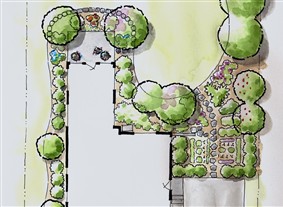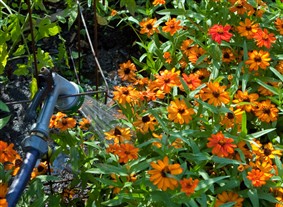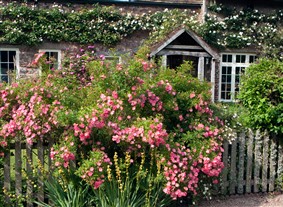Sustainable, Edible Garden Design
Views: 5374

Its true: kitchen gardens are not low maintenance gardens. Edible gardens require soil and bed preparation, annual planting, weeding, watering, and harvesting. A bountiful vegetable garden requires intensive commitment. A lush green lawn free of every kind of weed also requires intensive commitment.
I prefer to devote my energy to producing something to nibble on or flowers to cut than a perfect, flat, boring, expansive greenness.
A kitchen garden that is well designed and blends with your property is a tremendous source of joy, so grab your shovel and dig up your lawn. But do it in a way that makes sense.
The photo shows part of a garden I designed that incorporates layers of trees, shrubs, perennials, and annuals for a sensible and beautiful, useful garden.
Creating Boundaries in your Edible Garden
Use trees and flowering or edible shrubs to create the boundary of the garden. These large plants will form the visual space of the garden.
Large shrubs can provide some privacy, too. They can be placed in such a way to create mystery, so all the garden is not revealed at once. This is important if your new kitchen garden is going in your front yard, and you want to screen some of the garden from the full view of your neighbors.
Adding Flowers
Use annuals, perennials, and small flowering shrubs near the vegetable garden so as to attract beneficial insects and add fragrance and beauty. The flower nectar will attract either pollinators, like bees and hummingbirds or insects that attack the bad bugs like aphids.
Flowers and flowering shrubs can be cut. You can then bring in the dazzling delights of the garden indoors and plop them in vases. In my late summer garden, I harvest beans, tomatoes, and okra. But I am also picking bouquets of perennial sunflowers, asters, and zinnias for the table.
A Bountiful Garden
Use edible ground covers for the lowest layer of planting. Strawberries can be planted beneath fruit trees and flowering shrubs in spots where they will receive full sun. Fiddlehead ferns, ramps, and wintergreen can be planted in shady parts of the garden.
We used ornamental trees and large shrubs to create the form of the garden. We put the kitchen garden in a special place near the kitchen door and surrounded it with currant shrubs and perennial herbs.
Every level, from the high canopy to the mid-shrub layer and low-ground plane, was used to incorporate edible, useful, or flowering plants.
Meet Jennifer Bartley
Jennifer Bartley grew up on a ravine near an ancient Indian mound. She remembers spending glorious childhood days picking wildflowers and playing in an old,…
Jennifer's Recent Posts

Hand Watering the Kitchen Garden








